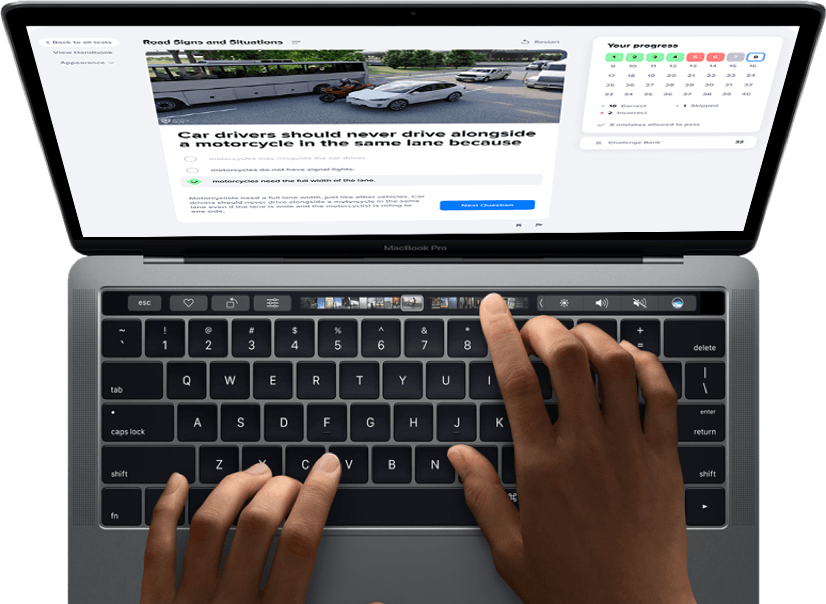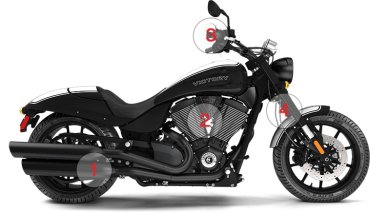
Learn how to get your IL learner's permit or driver's license and schedule your driving test in Illinois with this step-by-step guide. Discover what to expect, things you need, and how to get behind the wheel faster.

Pass your Illinois DMV driver's test the first time, guaranteed. Be fully prepared in days, not weeks with Premium.
Tell me more!
To drive in Illinois, you are required to hold a valid initial or full IL driver’s license. This is your full step-by-step guide that will help you get, renew or transfer your driver’s license fast and easy. If you're planning a road trip through Illinois's picturesque landscapes and might be driving a manual transmission car, make sure you're equipped with the right skills. Learn the essentials with our handy guide.
Pro tip: Cruising through Illinois's urban and rural roads requires skillful driving. Arm yourself with expertise using our guides on shifting gears manually and parallel parking. Learn how to adeptly navigate into parking bays and perform three-point turns. Proper mirror alignment enhances your driving safety. Engage with our Online Driving Simulator for additional practice, and ensure you comprehend Illinois's specific international driver's license guidelines.

It's a regular license that allows you to operate any motor vehicle with a gross vehicle weight rating (GVWR) that does not exceed 16,000 pounds and does not require a commercial driver's license. Read the IL Rules of the Road Manual or take a free IL DMV practice test.

Class A allows you to drive a combination of vehicles with a GCWR of 26,001 or more pounds, providing the GVWR of the vehicle being towed is in excess of 10,000 pounds. Class B is for driving a single vehicle with a GVWR of 26,001 or more pounds, or any such vehicle towing another not in excess of 10,000 pounds. Class C is for single vehicles with a GVWR of at least 16,001 pounds but less than 26,001 pounds. Read the IL CDL Study Guide or take a free CDL practice test.

It is a motorcycle classification on your driver's license. Class L is used for riding motor-driven cycles with less than 150 cc and Class M is for motorcycles. Read the IL Motorcycle Operator Manual or take a free IL motorcycle practice test.
To get your IL Driver’s License you should first collect the documentation required, pass your vision screening, written and driving tests. This is your complete plan of action depending on your age.
Apply for Instruction Permit Apply for Initial (Teen) Driver's License Apply for Full (Adult) Driver LicenseThe instruction permit is the first stage of Illinois's Graduated Driver Licensing program for everyone under the age of 18. It allows you to practice driving while supervised at all times by a responsible adult at least 21 years of age who is licensed and has at least one year of driving experience. If you are a foreign national who is not eligible for a Social Security Number, you may still qualify for a Temporary Visitor Driver's License (TVDL). In this case you may apply for the same kind of instruction permit.
You must apply for the instruction permit in person at a Secretary of State Facility. Note that the only Facilities that issue instruction permits to residents who are eligible for a Temporary Visitor Driver's License (TVDL) are the following: Bloomington, Carbondale, Champaign, Chicago North, Chicago West, Des Plaines, Macomb, Rockford Central, and Springfield (Dirksen Parkway).
To choose the documentation correctly use this list when applying for a regular instruction permit or this list while seeking a TVDL.
Your parent or guardian must accompany you to the Secretary of State Facility and give consent to your obtaining a permit.
Provide documentation that you are taking an approved driver's education course or will start to take one within the next 30 days at any public (not private) high school that offers it, or at a third-party provider. The course includes 30 hours of classroom instruction and 6 hours of driving practice.
If you already completed a driver's education course in another state, call the Secretary of State's office at (888) 261-5238 to find out whether you can get credit for your previous driver's education.
The minimum requirement for visual acuity is 20/40 with or without corrective lenses. Drivers with acuity between 20/41 and 20/70 are limited to daylight driving only.
The instruction permit fee is paid by cash, credit or debit card, personal check or money order. Note that if you obtain a driver's license before your instruction permit expires, you won't have to pay a fee for the driver's license later.
It is taken on a walk-in basis. Make sure you practice online before you go. You will have three chances to pass the test within the year from the date on which you pay the application fee for an instruction permit.
Your permanent (plastic) permit should be mailed to you within 15 business days. If you don't receive it, you can check its status by calling (217) 782-7044.
With your instruction permit, you must log at least 50 hours of supervised driving practice (including 10 hours at night) before you may apply for an initial (teen) driver's license.
The initial (teen) driver's license is the second stage of Illinois's Graduated Driver Licensing Program. It may be a Class D initial license or an initial Temporary Visitor Driver's License (TVDL). The initial license allows you to drive unsupervised at times, but with significant restrictions:
To choose the documentation correctly use this list for a class D initial license, or this list while seeking a TVDL.
When you turn 18, all restrictions on your unsupervised driving will end except for cell phone use. However, once you turn 19, that restriction will end too; you'll be able to use hands-free devices like any other adult driver. At that point, your initial license will grant you the same driving privileges as a full (adult) license.
To apply for a Class D or Temporary Visitor full (adult) driver's license, you must pass a vision test, a written exam, and a driving exam. Since you are at least 18 years of age, you don't have to hold an instruction permit.
First timer? Start with Step 1.
Instruction permit holder? Go to step 6.
It's required only for those under 21 years of age unless they already completed some driver's ed course once before. The course lasts 6 hours, and you may take it online or in a classroom. (No actual driving is involved.) A list of approved course providers is here.
Download your Certificate of Completion and provide it to the Secretary of State Facility.
You must apply for the license in person at a Secretary of State Facility. Note that not all the Facilities offer the same services. Check before you go.
You should verify the following:
To choose the documentation correctly use this list when applying for a regular license or this list while seeking a TVDL.
The minimum requirement for visual acuity is 20/40 with or without corrective lenses. Drivers with acuity between 20/41 and 20/70 are limited to daylight driving only.
It is taken on a walk-in basis. Make sure you practice online before you go. You will have three chances to pass the test within the year from the date on which you pay the application fee for the driver's license.
The fee is paid by cash, credit or debit card, personal check or money order.
Note that if you have an unexpired instruction permit, you won't have to pay a fee for the driver's license.
You will take the driving exam at a Secretary of State Facility on a walk-in basis. You have three chances to pass the test within the year from the date that you pay the application fee for the driver's license.
However, if you took a high school (not commercial) driver's education course and passed it with a grade A or B followed by the school's state-approved driving exam, you may bring your Cooperative Driver Testing Certificate to the Secretary of State Facility, and they may allow you to skip the road test (note that Secretary of State's office selects about 10 % of students at random to pass the official driving exam anyway.)
Your permanent (plastic) license should be mailed to you within 15 business days for a Class D license or 20 business days for a TVDL. If you don't receive it, you can check its status online or by calling (217) 782-7044.
How long your new Illinois driver's license will be valid depends on the type of license and your age when it's issued to you. If you're issued a Temporary Visitor Driver's License (TVDL), it will be valid for three years and expire on your birthday or when your stay in the US ends, whichever comes first. It cannot be renewed. If you still need driving privileges after it expires, you will have to apply for a new TVDL.
Every driver must take a written exam every 8 years, except a driver having no traffic convictions. You can take an IL written test at a Secretary of State facility on a walk-in basis.
What does the test include?The test consists of 35 multiple-choice or true-false questions that cover the contents of Illinois Rules of the Road Manual. You should be able to identify traffic signs by shape, color or symbol, know signals and pavement markings, traffic laws, safety rules, crash prevention and vehicle equipment.
How will I know if I have passed?You will be given your grade when you are finished. You must score 80% or above to pass, which means no more than 7 mistakes are allowed.
How can I prepare for the test?Study Illinois Rules of the Road Manual and take free practice tests available here. When you feel comfortable with your score, you are ready!
What common mistakes should I avoid?The most common mistake comes from not knowing enough information out of the handbook. This happens when people study solely with practice tests. Make sure you read the handbook first. Another problem is rushing through questions. Take your time and remember what you have studied.
Can I use the manual when taking the actual test?No, it’s considered cheating. Moreover, you mustn’t use your phone or other wireless devices. Anybody found cheating on any portion of the written exam will be failed and prohibited from retaking the exam for 30 days.
Can I take the oral exam instead of the written one?Yes. You can request an oral examination in person at any Secretary of State driver’s license facility, Monday through Thursday. The services are provided for those who may have a language barrier or any type of reading or learning disability.
What happens if I fail the test?You will still have 2 more attempts to take the test within a one-year period starting from the date of your first try.